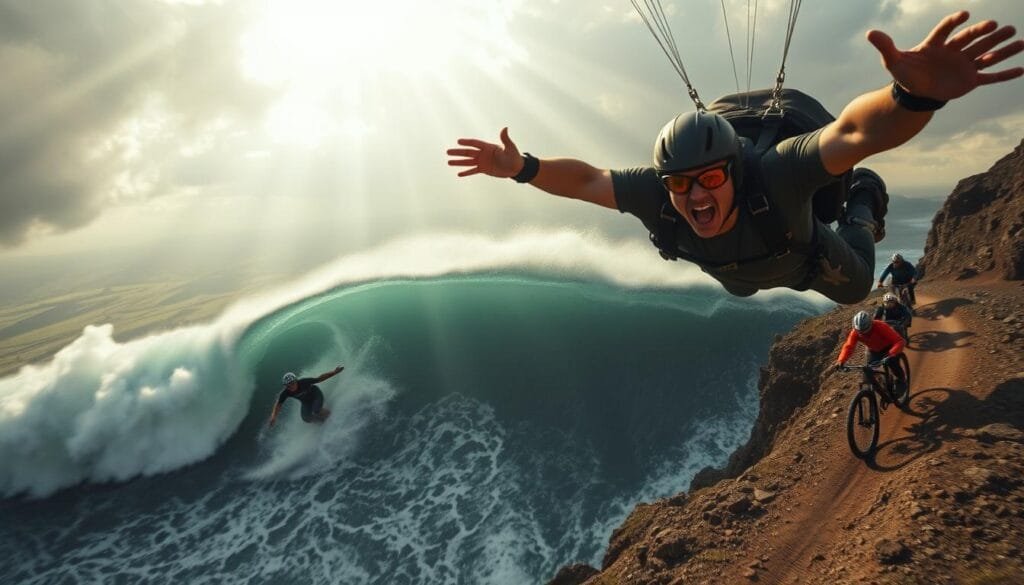Remember that moment when time slows? When your heartbeat drowns out the world and everything fades except the raw thrill of being alive? For those who chase that electrifying sensation, ordinary hobbies simply won’t cut it. This isn’t about checking boxes – it’s about rewriting your personal limits.
We’ve curated experiences that transform “what if” into “what’s next.” Imagine free-falling through cotton-cloud skies one day, then navigating raging whitewater the next. These pursuits demand more than courage – they require trust in your training, respect for nature’s power, and willingness to embrace the unpredictable.
From aerial feats that defy gravity to earthbound challenges testing physical endurance, each activity offers distinct rewards. Beginners will find welcoming entry points with professional guidance, while veterans discover fresh ways to test their mastery. The common thread? Life feels sharper when you’re fully present in these transformative moments.
Key Takeaways
- Discover activities spanning sky, land, and water environments
- Find options matching different skill levels and interests
- Learn how professional guidance makes these experiences accessible
- Understand the mental and physical benefits of calculated risk-taking
- Explore ways to transform fear into focused adrenaline responses
Introduction to Exhilarating Adventure Sports
Imagine trading screens for scenes that steal your breath. Where concrete jungles give way to untamed landscapes demanding your full attention. This realm rewards those who seek more than routine—it delivers life in high definition.

Think vertical drops where gravity becomes a dance partner. Picture navigating rivers that laugh at control. These pursuits aren’t about winning medals—they’re about rediscovering your edges. Professionals have transformed once-daunting feats into accessible journeys through:
- Progressive training systems breaking skills into manageable steps
- Cutting-edge safety gear tested beyond industry standards
- Local communities celebrating every first leap or climb
“You don’t conquer nature—you learn its rhythm,” says a veteran wingsuit instructor. That philosophy shapes modern approaches. Whether you’re rappelling into canyons or surfing tidal bores, certified guides help translate raw environments into personal breakthroughs.
Seasoned enthusiasts report unexpected benefits: sharper decision-making under pressure, renewed appreciation for mundane moments. The secret? Total immersion in challenges where every sense engages. Ready to trade spectatorship for stories worth retelling?
Understanding “adventure sports and activities for adrenaline junkies”
Ever felt your pulse skyrocket as you push beyond familiar boundaries? High-intensity pursuits blend calculated risks with pure exhilaration, creating experiences that rewrite your relationship with fear. Unlike casual hobbies, these disciplines demand full-body engagement and split-second choices where outcomes aren’t guaranteed.

“It’s not about danger—it’s about controlled vulnerability,” explains a BASE jumping coach. This mindset separates thrill-seekers from daredevils. Participants master environments through:
| Environment | Examples | Core Skills |
|---|---|---|
| Air | Paragliding, Wingsuit Flying | Altitude awareness, Wind reading |
| Water | Free Diving, Rapids Kayaking | Breath control, Current navigation |
| Land | Free Solo Climbing, Ultra Trail Running | Grip strength, Terrain analysis |
Why do you crave that heart-pounding rush? Science suggests it’s tied to dopamine surges during perceived threats. But enthusiasts report deeper rewards: unshakable focus during a cliff descent or the quiet pride after conquering freezing ocean swells.
Modern safety protocols transform once-unthinkable feats into achievable goals. Certified instructors use virtual reality simulations and graduated exposure techniques. Gear innovations like auto-deploy parachutes and biometric monitors add layers of protection without diluting intensity.
Your motivation matters. Whether seeking mental clarity or physical mastery, matching your goals to suitable challenges ensures growth. Start small—indoor skydiving before freefall, bouldering before multi-pitch climbs. Each step builds confidence for bigger leaps.
The Thrill and Appeal of Extreme Sports
Ever wondered why some people leap from cliffs or ride monstrous waves? High-intensity disciplines create a unique cocktail of risk and reward that rewires how we process fear. Unlike routine exercises, these pursuits demand total commitment – one hesitation can change everything.
Why They Stand Apart
What separates these from conventional competitions? Natural environments become both opponent and partner. You’re not battling other players but negotiating with elements that don’t care about your plans. This creates raw, unfiltered moments where success depends entirely on your choices.
| Aspect | Traditional Sports | Extreme Pursuits |
|---|---|---|
| Environment | Controlled fields | Wild, unpredictable |
| Focus | Strategy/teamwork | Survival instincts |
| Outcome | Predictable rules | Fluid conditions |
Chemistry of Courage
Your body becomes a biochemical laboratory during intense moments. That heart-pounding sensation isn’t just excitement – it’s norepinephrine sharpening your reflexes. Endorphins flood your system post-challenge, creating a natural euphoria that lasts hours.
Participants often describe a “flow state” where time distorts. This mental clarity carries over to daily life, helping tackle ordinary stresses with newfound perspective. As one free climber notes: “You learn more about yourself in 10 seconds on the wall than in 10 hours at the office.”
Conquering the Skies: Skydiving and Paragliding
What if you could trade solid ground for open air? Modern aerial disciplines let you challenge gravity while maintaining rigorous safety standards. Two distinct approaches dominate vertical exploration: high-velocity freefalls and wind-powered gliding.
Tandem vs. Solo Skydiving
First-time flyers often choose tandem jumps. You’ll harness to an instructor who manages gear checks, altitude tracking, and parachute deployment. This lets you fully absorb the 120mph freefall without technical responsibilities.
Certified solo divers enjoy creative control after completing:
- Ground school training (6-8 hours)
- Accelerated freefall courses
- 25 supervised jumps minimum
Byron Bay and Key West remain top destinations, offering ocean views during descent. Modern rigs feature automatic activation devices that deploy reserves if sensors detect unsafe speeds.
Essential Paragliding Safety Tips
Thermal riders prioritize preparation over thrills. Always:
- Inspect wing lines for wear before launch
- Check wind forecasts using aviation apps
- Practice ground handling at training hills
Swiss Alps pilots recommend starting with coastal sites before mountain flights. “Your gear only works if you respect weather limits,” notes a 20-year instructor. Post-flight debriefs help identify improvement areas for next time.
Both activities transform fear into focus – skills that translate to everyday decision-making. Whether you’re plummeting earthward or riding updrafts, certified operators ensure your sky journey stays exhilarating yet controlled.
Diving into the Deep: Scuba Diving with Sharks
What lies beneath the ocean’s surface transforms ordinary breathing into something extraordinary. SCUBA—self-contained underwater breathing apparatus—grants access to silent realms where gravity loosens its grip. Here, schools of fish become moving sculptures, and coral cities pulse with life unseen from dry land.
Shark encounters redefine human-scale perspectives. Operators in Guadalupe Island and Fiji use cage-free setups for observing great whites and bull sharks. “They’re not mindless hunters—they’re curious architects of marine balance,” notes a marine biologist with 300+ dives. Controlled exposure through professional guides helps dismantle myths while prioritizing safety.
Exploring Underwater Thrills
Certification matters more than courage here. Open-water courses teach essential skills:
- Equalizing ear pressure during descent
- Reading dive computers for depth/time limits
- Handling regulator malfunctions
The water becomes your meditation chamber. Rhythmic breathing slows your pulse as you hover above reef drop-offs. Unlike skydiving’s explosive rush, this sport rewards patience—waiting minutes might reveal a manta ray’s graceful glide or octopus camouflage.
Conservation drives modern shark tourism. Your presence funds research on migratory patterns and reef protection. Advanced divers can explore WWII wrecks in Truk Lagoon or underwater caves in Mexico, each dive blending history with ecological awareness.
Above the Ground: Bungee Jumping Adventures
What transforms a single heartbeat into a lifetime memory? Standing at the edge, toes curling over steel platforms, you confront the ultimate trust exercise with physics. Bungee jumping involves leaping into emptiness while tethered to high-tech cords – a dance between gravity’s pull and engineered resilience.
Modern operations use triple-check systems for security. Your harness connects to primary and backup cords rated for five times your weight. Operators run precise calculations considering wind speed, jump height, and cord elasticity. “We turn fear into physics,” says a Dubai jump master with 12,000 supervised leaps.
| Jump Type | Height Range | Environment | Unique Feature |
|---|---|---|---|
| Bridge | 150-400 ft | Over rivers/canyons | Natural acoustics amplify screams |
| Platform | 300-700 ft | Urban/constructed | Panoramic city views during rebound |
The initial drop delivers 3-5 seconds of pure freefall. Stomach-flipping weightlessness shifts into elastic recoil as cords stretch. Belgrade’s 250-foot bridge jumps let you skim water before bouncing skyward again.
Pre-jump rituals matter. Guides walk you through controlled breathing techniques while checking gear. That final step becomes a meditation – focusing on courage rather than consequences. Many find this momentary surrender unlocks lasting confidence in daily challenges.
Scaling New Heights: Rock Climbing Experiences
Ever stared at a cliff face and felt your fingers itch? Vertical landscapes become living puzzles where every crack and ledge tells a story. Rock climbing blends physical mastery with mental chess – you’ll read routes like maps while building iron grip strength.
Beginners often start with top-rope systems. A partner manages safety ropes from below, letting you focus on movement. Advanced climbers graduate to lead techniques, placing protective gear mid-ascent. Each style teaches unique problem-solving skills.
Choosing Your Vertical Path
Free climbing demands pure body control. You use ropes only to catch falls, never to pull upward. It’s like dancing on granite – every toe placement matters. Roped systems add security through belay devices, ideal for tackling multi-pitch routes that test endurance.
Bouldering offers quick bursts of intensity. Short, powerful sequences on smaller rock formations hone precision. Crash pads cushion landings as you practice dynos (jumping moves) and mantling techniques.
Whether you’re gripping sandstone in Utah or schist in New England, certified guides help decode each rock type’s personality. Start with indoor gyms to build foundational skills before taking on nature’s walls. Your first summit smile will rewrite what you think is possible.
FAQ
How safe is skydiving for first-timers?
Modern skydiving uses advanced safety gear like automatic activation devices and dual parachutes. Tandem jumps with certified instructors, such as those at Drop Zones in Florida or California, minimize risks. Always check the operator’s USPA membership for credibility.
What’s the difference between free climbing and roped climbing?
Free climbing relies on your strength and skill to ascend natural rock features, using ropes only for safety. Roped climbing involves attaching protective gear (like Black Diamond cams) to the wall as you move. Yosemite’s El Capitan offers iconic routes for both styles.
Can you scuba dive with sharks without cages?
Yes! Destinations like the Bahamas or South Africa’s Protea Banks allow open-water dives with reef sharks or hammerheads. Operators like PADI-certified guides ensure protocols are followed, such as avoiding sudden movements and wearing dark wetsuits.
What gear do I need for paragliding?
Essential items include a certified wing (like Ozone or Gin Gliders), a harness, reserve parachute, helmet, and variometer. Thermal-friendly clothing and sturdy hiking boots are recommended for launches in places like Utah’s Point of the Mountain.
Is bungee jumping scarier than base jumping?
Both deliver intense adrenaline rushes, but base jumping from cliffs or structures (e.g., Norway’s Kjerag) involves higher speeds and shorter freefalls. Bungee jumping, like the 876-foot jump at the Macau Tower, offers a controlled rebound effect with thicker cords.
Where can I combine multiple adventure sports in one trip?
Moab, Utah, blends rock climbing on Fisher Towers with mountain biking the Slickrock Trail. Interlaken, Switzerland, lets you paraglide over the Alps before whitewater rafting the Lütschine River. Check local operators for guided multi-sport packages.